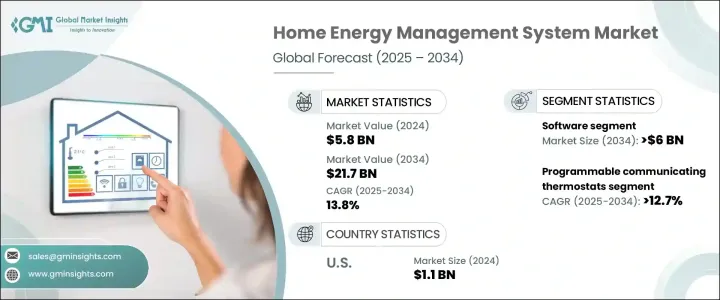
세계의 가정용 에너지 관리 시스템 시장 규모는 2024년에 58억 달러로 평가되었고, 스마트 홈 기술의 채용 증가 및 환경 지속가능성에 대한 관심 증가를 배경으로 CAGR 13.8%로 성장할 전망이며, 2034년에는 217억 달러에 달할 것으로 예측됩니다.
이산화탄소 배출량 감소에 대한 세계 변화, 에너지 효율적인 기술 진보, 신재생 에너지원의 주택에 대한 통합 등 여러 요인들이 시장 확대에 박차를 가하고 있습니다. IoT와 AI 기술의 채용은 HEMS의 강화에 중요한 역할을 하고 있으며, 사용자는 사용 패턴에 근거한 온도 설정의 조정이나 피크시의 소비 삭감과 같은 에너지 절약 액션을 자동화할 수 있습니다. AI를 탑재한 시스템은, 에너지 절약 제안을 한층 더 개인화해, 시스템 전체의 효율을 향상시킵니다.

에너지 효율을 촉진하는 정부의 프로그램 및 규제도, 가정용 에너지 관리 솔루션의 채용을 가속하는 데 있어 매우 중요한 역할을 하고 있습니다. 세계 각국의 정부가 제공하는 다양한 인센티브나 리베이트는 소비자에게 에너지 절약 기술에 대한 투자를 촉구하고 있습니다. 엄격한 에너지 사용 규제는 야심찬 기후변화 목표와 맞물려 에너지 소비를 최적화하는 스마트홈 솔루션에 대한 투자를 소비자에게 독려하고 있습니다.
| 시장 범위 | |
|---|---|
| 시작 연도 | 2024년 |
| 예측 연도 | 2025-2034년 |
| 시작 금액 | 58억 달러 |
| 예측 금액 | 217억 달러 |
| CAGR | 13.8% |
가정용 에너지 관리 시스템 시장은 2024년까지 58억 달러로 평가되었습니다. 광열비 급등 및 환경 문제에 대한 관심 고조가, 소비자가 에너지 비용과 카본 풋 프린트를 삭감하는 대체 수단을 요구하는 동기가 되고 있습니다. 서모스탯, 조명 시스템, 전기 자동차(EV) 충전기 등의 스마트 디바이스의 가정에 대한 통합이 진행되어 HEMS의 채용이 가속하고 있습니다. 에너지 효율에 대한 수요가 계속 높아지는 가운데 스마트홈 기술을 채택하는 가정이 늘고 있습니다.
프로그래머블 통신 서모스탯 분야는 2034년까지 연평균 복합 성장률(CAGR) 12.7%로 확대하여 대폭적인 성장을 견인할 것으로 예측되고 있습니다. 이러한 서모스탯은 프리셋 스케줄링, 원격 온도 조정, 실시간 모니터링 등의 고급 기능을 갖추고 있어 에너지 소비를 대폭 줄이고 광열비를 절감합니다. 그 결과 지속 가능성과 비용 효율을 우선시하는 소비자들 사이에서 인기가 높아지고 있습니다. 주택 소유자가 자택의 냉난방 시스템을 보다 잘 제어할 수 있도록 함으로써, 이러한 기기는 에너지 사용을 최적화하고, 에너지 효율이 높은 주택을 목표로 하는 확대 경향에 불가결한 요소가 되고 있습니다.
미국의 가정용 에너지 관리 시스템 시장은 2024년에 11억 달러에 이르렀으며, 스마트 홈 기술의 광범위한 채용으로 HEMS 시장의 견고한 기반이 형성되고 있습니다. 스마트 서모스탯, 조명 제어 및 기타 IoT 지원 장치는 집중 에너지 관리 시스템에 원활하게 통합되어 사용자에게 에너지 소비의 실시간 제어를 제공합니다.
세계의 가정용 에너지 관리 시스템 시장의 주요 기업으로는 Siemens, Toshiba, Honeywell, Schneider Electric, and Johnson Controls 등이 있습니다. 이러한 기업은, 시장에서의 존재감을 높이기 위해서, 스마트 기술의 혁신, 고객 인게이지먼트 전략, 전략적 파트너십에 주력하고 있습니다. 또한 많은 기업들이 지속 가능한 솔루션에 투자하고, 에너지 효율적인 주택 관리 시스템에 대한 수요 증가에 대응하기 위해 제품 포트폴리오를 확대하고 있습니다. 게다가 전략적 합병, 인수, 제휴는 시장으로의 리치를 확대하고 기술력을 강화하기 위한 일반적인 전략입니다.
The Global Home Energy Management System Market was valued at USD 5.8 billion in 2024 and is estimated to grow at a CAGR of 13.8% to reach USD 21.7 billion by 2034 driven by the increasing adoption of smart home technologies and growing environmental sustainability concerns. Several factors, such as the global shift toward reducing carbon emissions, advancements in energy-efficient technologies, and the integration of renewable energy sources into homes, are fueling market expansion. The adoption of IoT and AI technologies has played a significant role in enhancing HEMS, enabling users to automate energy-saving actions such as adjusting temperature settings based on usage patterns and reducing consumption during peak hours. AI-powered systems further personalize energy-saving recommendations, improving the overall system efficiency.

Government programs and regulations promoting energy efficiency have also played a pivotal role in accelerating the adoption of home energy management solutions. Various incentives and rebates offered by governments worldwide encourage consumers to invest in energy-saving technologies. Stringent energy usage regulations, coupled with ambitious climate targets, are pushing consumers toward investing in smart home solutions that optimize energy consumption.
| Market Scope | |
|---|---|
| Start Year | 2024 |
| Forecast Year | 2025-2034 |
| Start Value | $5.8 Billion |
| Forecast Value | $21.7 Billion |
| CAGR | 13.8% |
The home energy management system market was valued at USD 5.8 billion by 2024. Rising utility prices and increasing environmental concerns motivate consumers to seek alternatives that reduce energy costs and carbon footprint. The growing integration of smart devices such as thermostats, lighting systems, and electric vehicle (EV) chargers into homes accelerates the adoption of HEMS. As the demand for energy efficiency continues to rise, more households are adopting smart home technologies.
The programmable communicating thermostat segment is anticipated to drive substantial growth, expanding at a CAGR of 12.7% through 2034. These thermostats are designed with advanced features like preset scheduling, remote temperature adjustments, and real-time monitoring, which significantly reduce energy consumption and lower utility bills. As a result, they are becoming increasingly popular among consumers who are prioritizing sustainability and cost efficiency. By allowing homeowners to have better control over their home's heating and cooling systems, these devices optimize energy use, making them an integral part of the growing trend toward energy-efficient homes.
United States Home Energy Management System Market reached USD 1.1 billion in 2024 and is poised for continued growth due to the widespread adoption of smart home technologies is creating a solid foundation for the HEMS market as consumers increasingly seek interconnected solutions to manage their home's energy use more effectively. Smart thermostats, lighting controls, and other IoT-enabled devices are seamlessly integrated into centralized energy management systems, offering users real-time control over their energy consumption.
Major companies in the Global Home Energy Management System Market include Siemens, Toshiba, Honeywell, Schneider Electric, and Johnson Controls. These companies are focusing on innovations in smart technologies, customer engagement strategies, and strategic partnerships to strengthen their presence in the market. Many companies are also investing in sustainable solutions and expanding their product portfolios to meet the growing demand for energy-efficient home management systems. Additionally, strategic mergers, acquisitions, and collaborations are common strategies to expand market reach and enhance technological capabilities.